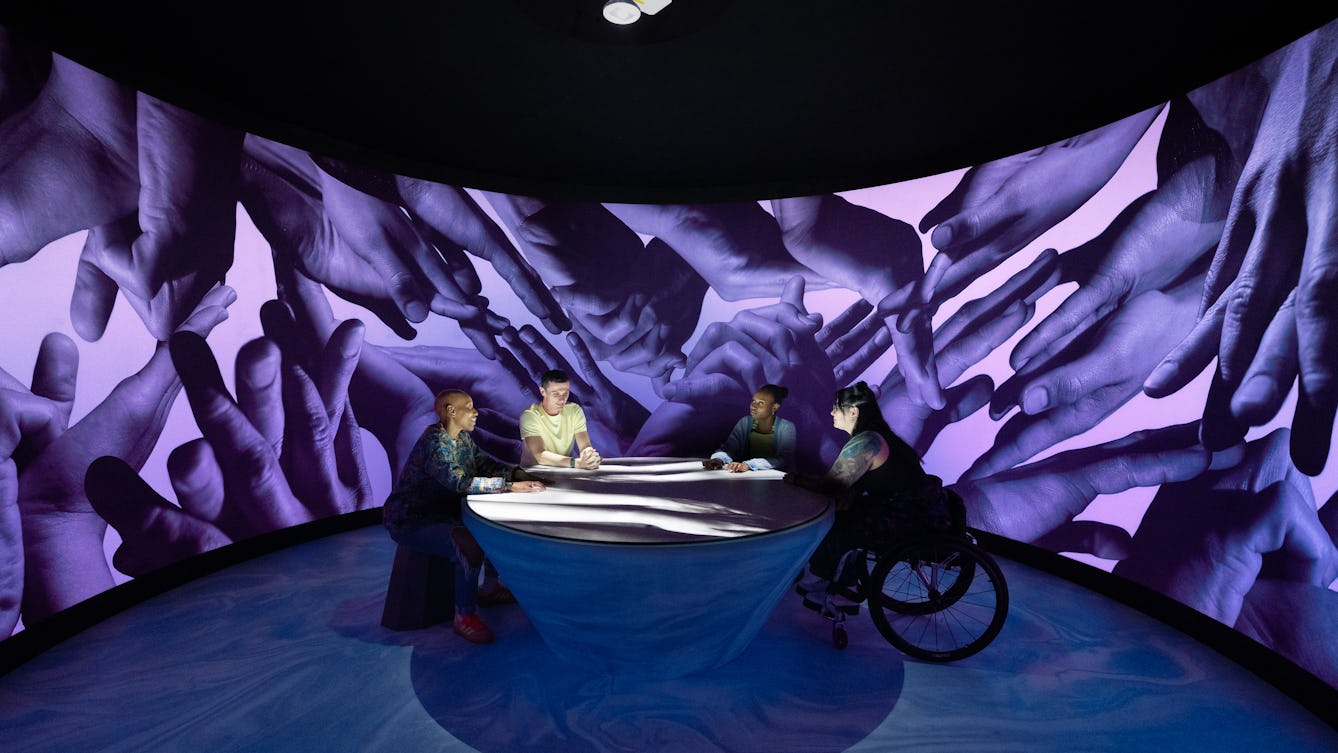This installation contains flashing lights and loud sound. You are welcome to touch the table in the centre of the room, which vibrates in time with the soundtrack. There is seating around the table.
Hello. This is Cindy Sissokho, the exhibition curator again.
Moi Tran is a Vietnamese artist based in London. Her installation ‘Care Chains (Love will continue to resonate)’ is through the entrance to your right. She made this work in collaboration with a team of practitioners including musicians, a body percussionist, composers, a sound designer, a sound artist, a dancer and members from the organisation The Voice of Domestic Workers.
The Voice of Domestic Workers provides educational and community activities campaigning for domestic workers’ rights in the UK. Each year over 23,000 workers – predominantly women – migrate to the UK from countries including the Philippines, Kenya and Nigeria to work as domestic workers in private households.
‘Care Chains (Love will continue to resonate)’ asks us to consider how giving care is more than a physical act. It is transmitted through labour but resonates beyond it to impact people’s lives in many visible and invisible ways.
The installation is a circular room, 7 metres wide, with a curved fabric wall printed with a collage of larger-than-life black-and-white photographs of people’s bodies in movement. Light radiates from the outside of the wall, bathing the room in a dim, gentle lilac. In the centre of the room – directly in front as you move through the doorway and across the sky-blue marbled floor – is a low circular table, 2 metres wide, surrounded by sky-blue cloud-shaped seats. A black-and-white video is projected onto the tabletop from above, playing on a continuous loop.
In the video, women perform body percussion choreography, using their bodies as instruments to clap, click, stomp and snap their fingers. The camera focuses on the performers’ arms and hands; their practised gestures are caught in close-up, duplicated, fragmented and sometimes blurred. Short-sleeved mesh tops are laid over pale, loose-fitting dresses and white three-quarter-length trousers, their side seams and hems forming dark, bold lines. We follow the performers’ rhythmic repetitions, standing with their arms by their sides, the backs of their hands meeting at the stomach, surging upwards in unison, sliding over their heads, palms probing the air – then returning to neutral poses with their arms hanging relaxed by their sides again. In a close-up, the upward stroke of a hand cups a cheek, but the performers’ faces remain largely out of shot, or only glimpsed in part.
Some performers play musical instruments, the cello and trombone. They stand in a circle, facing out, and gradually gather in a huddled formation, bodies moving closer and closer. The rhythmic soundtrack fills the room – humming, clapping and vocalising accompanied by the musical instruments. The tabletop vibrates to the rhythm of the soundtrack, and the lighting in the room pulses in harmony – creating an otherworldly and soothing atmosphere.
Domestic workers perform acts of care in the homes of their employers, cooking, cleaning and attending to children. They are expected to be warm and friendly, meeting both the emotional and physical needs of the household. The long hours they spend with their employer are at the expense of time with their own families, as many must travel away from their home countries to do this work.
For many of the domestic workers, performing is a way to release tension from the strain of their labour, or to process traumatic workplace experiences. In the UK, domestic workers are reliant on their employer to renew their work visa and can feel trapped in exploitative or unsafe working conditions, unable to change their employer without losing their right to work.
Over several months, on Sundays, members of The Voice of Domestic Workers met with Moi Tran and her other creative collaborators to create this performance. The performance focuses on the body as an instrument of communicating care, leading us to consider broader questions around the universal and powerful notions of care and caring for one another. The workers were encouraged to redirect their bodies’ labour and energies towards love, joy and collective resistance. Their performance expresses their creativity and collective strength – bringing together women who work in isolation within the confines of their employer’s home.
This is the end of the last stop of the audio guide. Continue listening if you would like guidance on leaving the exhibition.
To exit the exhibition, leave the ‘Care Chains (Love will continue to resonate)’ installation by the way you entered and turn right. At the end of the green corridor, you will have a locker room on your left. To get back to the Atrium, turn right here, passing the lifts on your right. You are, of course, welcome to stay and explore.
